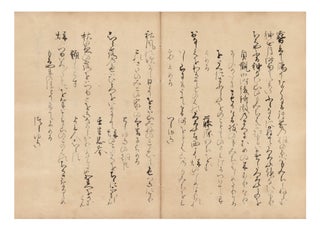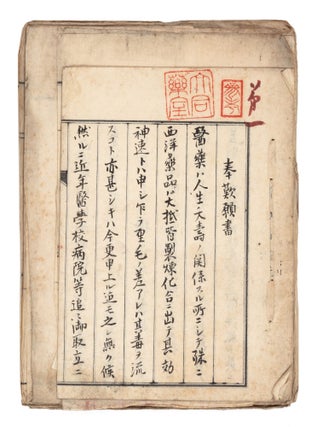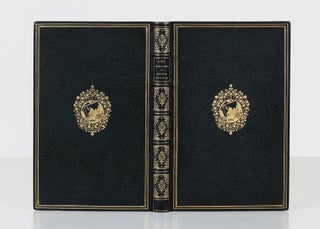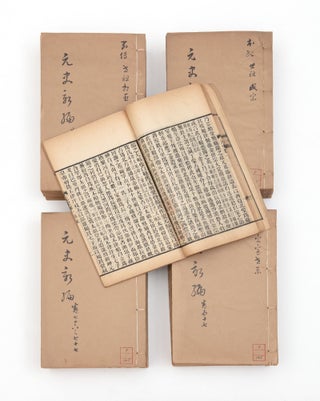The Beginnings of Waka Poetry
Manuscript on paper of the first three imperially commissioned waka anthologies: Kokin wakashu, Gosen wakashu, & Shui waskashu, collectively known as Sandaishu. Each written on fine torinoko paper with beautiful calligraphy.
155; 203; 176 leaves of text (plus a few blank leaves at beginning & end of each vol.). Three vols. 8vo (246 x 173 mm.), a cont. tetsuyoso binding, gold silk endpapers with patterns of pine trees & sprays of gold (kindei, “golden mud”), with gold silk brocade over semi-stiff wrappers, red silk manuscript title labels on upper covers. [Japan]: 1707?
A beautifully calligraphed manuscript, in three volumes, of the Sandaishu [“collection of three reigns”], the collection of the first three of 21 imperially commissioned waka poetry anthologies compiled from 905 to 1439. These three collections are:
1. Kokin wakashu, compiled ca. 905-20;
2. Gosen wakashu, compiled 951 ff.;
3. Shui wakashu, compiled 1005-11.
These first three “provided the model of language; in formal poetry thereafter, a poet was expected to use that word hoard (although innovations were made). The first of the twenty-one set the organizational principles for the rest…The conception underlying the [first] collection no doubt reflected then existing ideas about poetry. But it realizes them so well and so influentially that to some degree all Japanese poetry before 1868 is conceivable only on its terms.”–Miner et al., eds., The Princeton Companion to Classical Japanese Literature (1985), p. 342 & p. 187.
The Kokin wakashu was envisioned by Emperor Uda (reigned 887-97) and ordered by Emperor Daigo (reigned 897-930), perhaps in 905. These 1111 poems were selected by Ki no Tsurayuki, Ki no Tomonori, Oshikochi Mitsune, and Mibu no Tadamine. Most of the poems reflect actual life, making them the ancestor of renga and haikai. The customary arrangement of themes was set in this collection: the four seasons, congratulations, partings, travel, acrostics, love, laments, miscellaneous subjects, and traditional poems from the Bureau of Poetry.
The Chinese preface was written by Ki no Yoshimochi (d. 919), and the Japanese preface by Ki no Tsurayuki (ca. 872-945). This Japanese preface of Kokin wakashu is of considerable literary importance not only as a wakashu but also as a treatise on waka poetry that had a significant influence on Japanese poetry in the years to come.
Accompanying these manuscripts is a one-sheet document (368 x 540 mm.) written by Kohitsu Ryo’on (1674-1725), dated “early spring at the end, 1707,” stating that each of these volumes was calligraphically written by a famous aesthete: Vol. I: Nakanoin Dainagon Michimi (1668-1740); Vol. II: Asukai Chunagon Masatoyo (1664-1712); Vol. III: Hino Chunagon Tarumitsu (1670-1717). All three were court nobles, waka poets, and connoisseurs of fine calligraphy. As is usual, these men did not sign their names.
The torinoko paper used for the volumes is very fine and thick, enabling the scribes to write on both sides of each leaf without show-through.
Kohitsu was the sixth-generation member of a family (of at least 15 generations) of aesthetes and connoisseurs who were reputable authorities for authenticating paintings and calligraphy throughout the Edo period. His document is written on fine, thick and heavy torinoko paper with patterns of faint clouds or landscapes in other fibers. Kohitsu has signed the document and placed his seal on it. The document is placed in two layers of envelopes.
Fine and fresh copies. These manuscripts are placed in a luxurious (but somewhat worn) silk brocade chitsu with endpapers decorated with golden sprays of kindei (“golden mud”). The manuscripts have then been placed in two somewhat damaged old wooden boxes. The inner box is very handsome, revealing the fine grain of wood, with the title of the collection written using beautiful gold lacquer.
Price: $15,000.00
Item ID: 8686




![Pak Ssi ch’irhyŏn kŏŭi rok [or] Pak Ssi chirhyeon geoeui rok. Chae-hwan PAK, Je-hwan or PAK.](https://jonathanahill.cdn.bibliopolis.com/pictures/9425.jpg?width=320&height=427&fit=bounds&auto=webp&v=1694206663)


